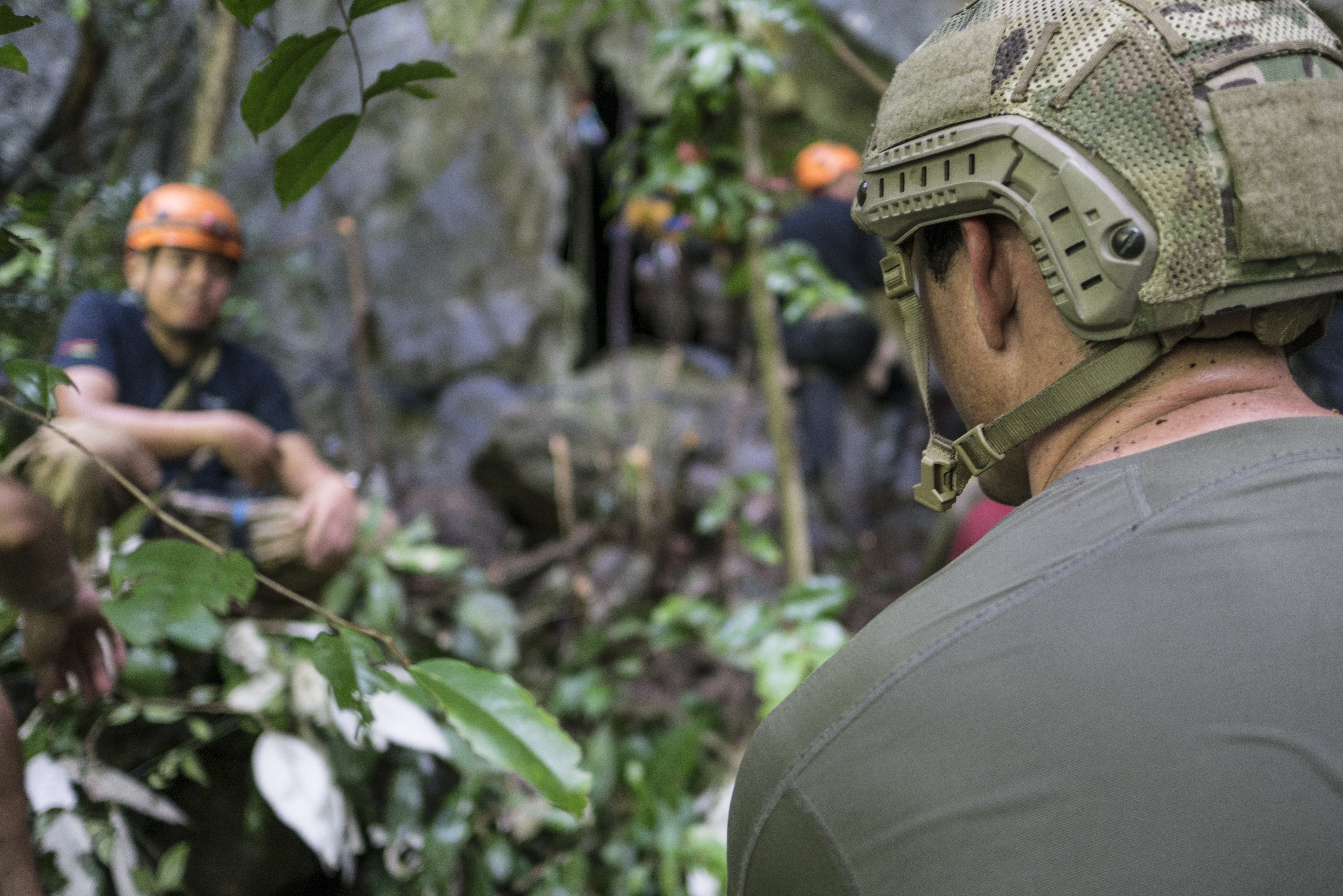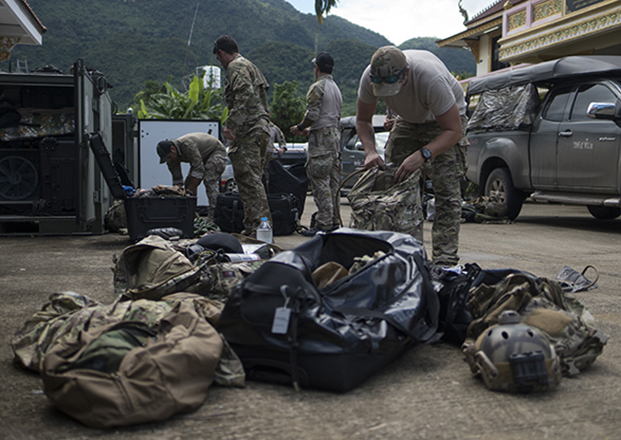
Airmen from the US Indo-Pacific Command exchange knowledge with Thai authorities July 1, 2018, at Chiang Rai, Thailand. USAF photo by Capt. Jessica Tait.
KADENA AB, Japan—SSgt. James Brisbin was on vacation with his family in Kyoto, Japan, when he got the call on June 27. The search and rescue pararescueman with the 31st Rescue Squadron had already planned to return home to Okinawa that afternoon, but when he arrived at Naha Airport, he was “scooped up curbside” and taken straight to the Kadena flight line, where he walked onto the waiting C-130 with a few days’ stubble, wearing board shorts and a T-shirt.
Maj. Charlie Hodges, commander of the 320th Special Tactics Squadron, was sitting in the cockpit, because the normal passenger area was too full for him to find a seat. Hodges, Brisbin, and about 30 other airmen knew they were headed to Thailand for a search and rescue effort involving a cave, flooding, and mountains, but they didn’t know much else.
The team became part of the Thai-led multinational effort to rescue 12 boys and their soccer coach, who had hiked into a labyrinthine cave system and were trapped inside when water flooded the caves.
At first, rescuers were not sure the boys and their coach were still alive, and they did not know exactly where they were. But after days of searching for alternate routes into the caves, two British divers found the boys and their coach safe, deep inside the cave.
Though some people had proposed taking food and water to the team and letting them wait out the rainy season, others were concerned that oxygen would run out before they could make it out. They decided to use a plan created by the Thai military and the international team to dive into the cave and bring the boys out, one by one.
 Airmen from US Indo-Pacific Comman?d prepare their tactical gear in preparation for a combined land survey with Royal Thai military partners June 28, 2018, at Chiang Rai, Thailand. USAF photo: Capt. Jessica Tait.
Airmen from US Indo-Pacific Comman?d prepare their tactical gear in preparation for a combined land survey with Royal Thai military partners June 28, 2018, at Chiang Rai, Thailand. USAF photo: Capt. Jessica Tait.
The plan was not easy; Maj. Craig Savage, a spokesman for Air Force Special Operations Command, said the dive operations carried “significant risk and probable death,” but noted that the Thai government’s decision to approve the plan demonstrated its confidence in the Thai Navy Seals and the international team of rescuers, as well as the government’s commitment to rescue the boys and their coach.
The boys had to be sedated to prevent them from panicking underwater, Savage said. An Australian anesthesiologist and an Australian veterinarian were stationed with the team and coach in what the team called “Chamber Nine,” to sedate each child before the dive began. Escort divers would guide each sedated boy through the nine chambers to the mouth of the cave, taking care not to let them collide with a rock or wall that could dislodge their face masks.
Additional divers from Thailand, Europe, and the US were stationed throughout the cave’s other eight chambers. Brisbin, who was a cave diving enthusiast before he joined the Air Force, and USAF SSgt. John Merchand manned Sump 3, a semi-submerged hollow, narrow pathway, helping move the boys from Chamber Three to Chamber Two.
Brisbin described Sump Three as about 20 feet wide, but only two or three feet high.
Hodges, who served as the mission commander for the US rescue team, said it took the divers anywhere from three to four hours to move a child from Chamber Nine to Chamber Three. It could then take an additional hour or more to get to the mouth of the cave, where the children were sent to a field hospital and then a waiting ambulance.
“Throughout this entire cave, from the mouth back to Chamber Nine, where the kids are, there’s many, many sections, some of which are fully submerged underwater, some of which are partially submerged—so maybe you’re swimming or wading but your head is above water—and there are sections that are completely dry,” Brisbin explained.
The layout of the cave is “as if you create a tunnel through the rock that is traveling in random directions, and then you dump a bunch of boulders into that,” Brisbin continued.
Divers had to climb and swim through the space between the rocks, some of which were “the size of a human rib cage,” forcing them to take their dive gear off to be able to squeeze through, he said.
But despite the extreme difficulty of the mission and a number of very close calls, the international team was able to rescue all 12 boys and their coach.
“We absolutely took some risks,” Hodges said, noting that they thought it would turn out well but weren’t certain it would turn out as well as it did.
“My guys knocked it out of the park,” he said.